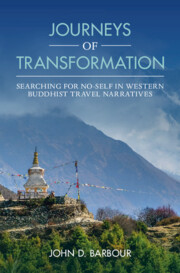Book contents
- Journeys of Transformation
- Reviews
- Journeys of Transformation
- Copyright page
- Dedication
- Contents
- Acknowledgments and Author’s Note
- Introduction A Literary Genre and Some Questions about Self-Transformation
- Chapter 1 The Origins of the Genre
- Chapter 2 Peter Matthiessen’s The Snow Leopard and Nine-Headed Dragon River
- Chapter 3 In a Zen Monastery
- Chapter 4 Thomas Merton and Christian and Jewish Pilgrims in Buddhist Asia
- Chapter 5 Walking the Dharma on Shikoku and in India
- Chapter 6 Trekking and Tracking the Self in Tibet
- Chapter 7 Life-Changing Travels in the Tibetan Diaspora
- Chapter 8 Encounters with Theravada Buddhism
- Chapter 9 Searching for Chan Buddhism after Mao
- Conclusion Theories of No-Self, Stories of Unselfing, and Transformation
- Bibliography
- Index
Chapter 2 - Peter Matthiessen’s The Snow Leopard and Nine-Headed Dragon River
Published online by Cambridge University Press: 12 March 2022
- Journeys of Transformation
- Reviews
- Journeys of Transformation
- Copyright page
- Dedication
- Contents
- Acknowledgments and Author’s Note
- Introduction A Literary Genre and Some Questions about Self-Transformation
- Chapter 1 The Origins of the Genre
- Chapter 2 Peter Matthiessen’s The Snow Leopard and Nine-Headed Dragon River
- Chapter 3 In a Zen Monastery
- Chapter 4 Thomas Merton and Christian and Jewish Pilgrims in Buddhist Asia
- Chapter 5 Walking the Dharma on Shikoku and in India
- Chapter 6 Trekking and Tracking the Self in Tibet
- Chapter 7 Life-Changing Travels in the Tibetan Diaspora
- Chapter 8 Encounters with Theravada Buddhism
- Chapter 9 Searching for Chan Buddhism after Mao
- Conclusion Theories of No-Self, Stories of Unselfing, and Transformation
- Bibliography
- Index
Summary
Peter Matthiessen’s The Snow Leopard (1978) is the best-known Western Buddhist travel narrative and the classic text that for most readers defines the genre. This chapter explores Matthiessen’s account of his two-month trip to Nepal to search for Himalayan blue sheep and the rare snow leopard, mourn his wife’s death, search for a spiritual guide, and practice Buddhist mindfulness and compassion. He describes several incidents of unselfing as well as his frustration in persisting in this longed-for state of being. Matthiessen’s later Nine-Headed Dragon River describes his shift from Rinzai to Soto Zen and culminates in a pilgrimage to Zen monasteries in Japan. He examines how the student–teacher relationship calls for submission of the ego. He presents transformation as an aspect of individual experience as well as the process by which Zen changed as it moved from China to Japan to America. In Nine-Headed Dragon River, the meaning of no-self is no longer a state to be achieved in a dramatic moment but rather offers a crucial perspective from which to understand his relationship to his Zen master and Zen’s journey through various cultures.
Keywords
- Type
- Chapter
- Information
- Journeys of TransformationSearching for No-Self in Western Buddhist Travel Narratives, pp. 43 - 62Publisher: Cambridge University PressPrint publication year: 2022



